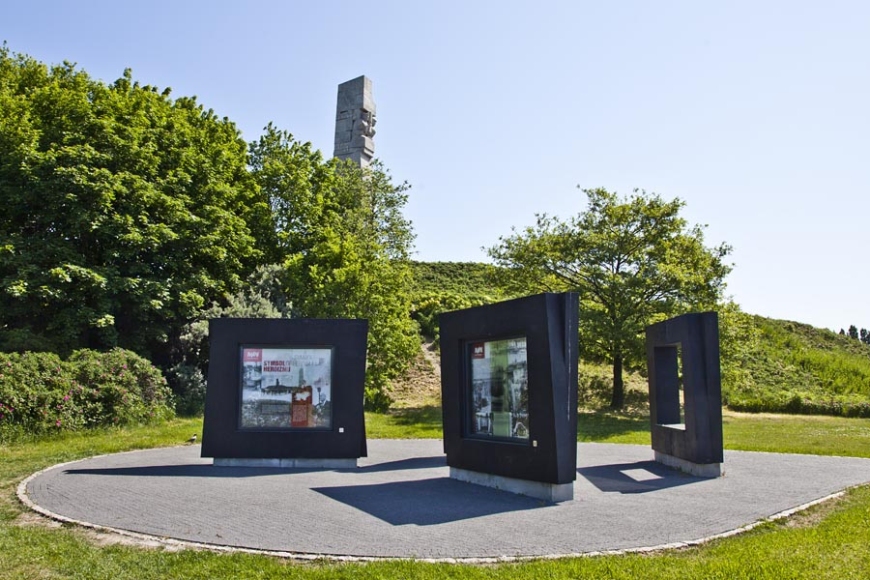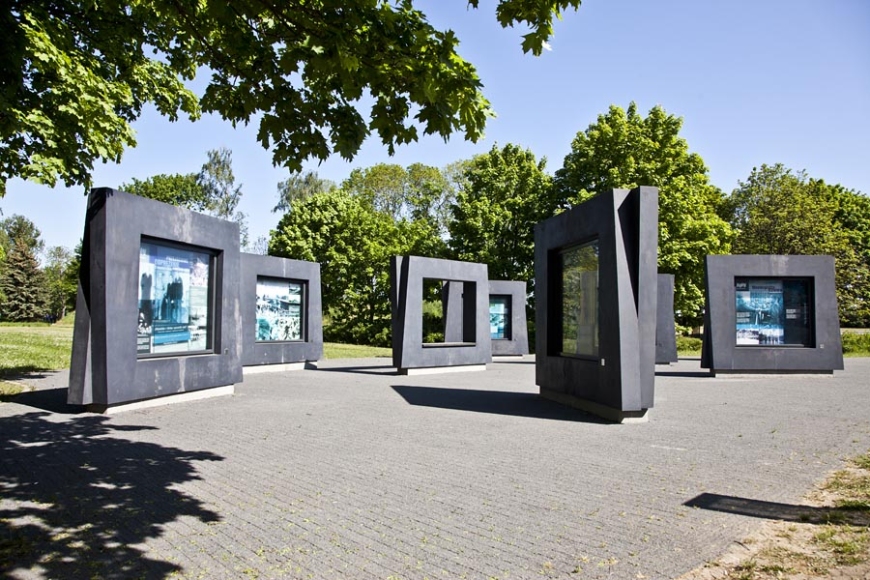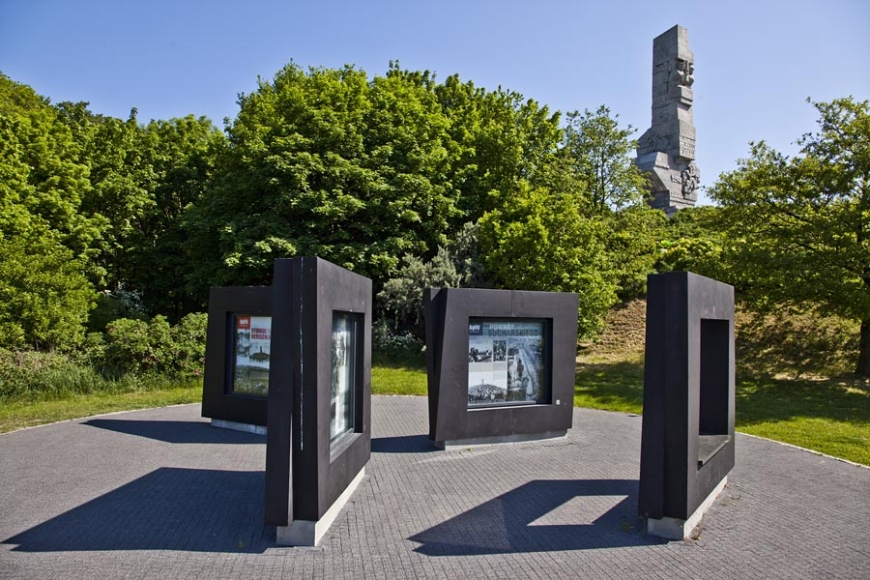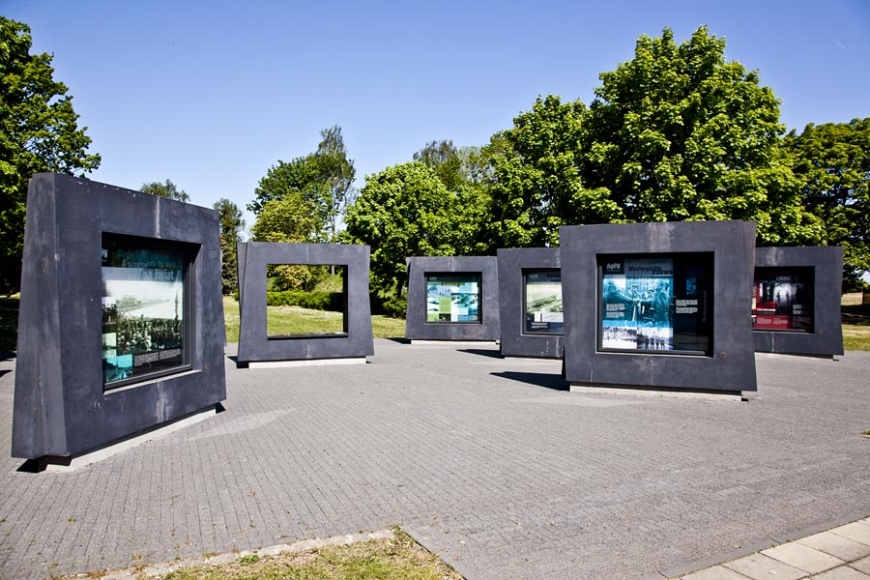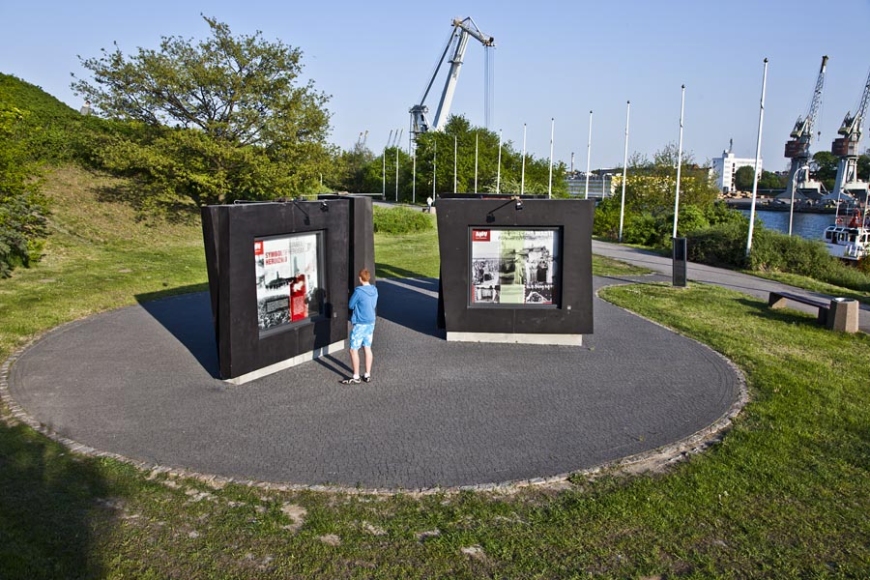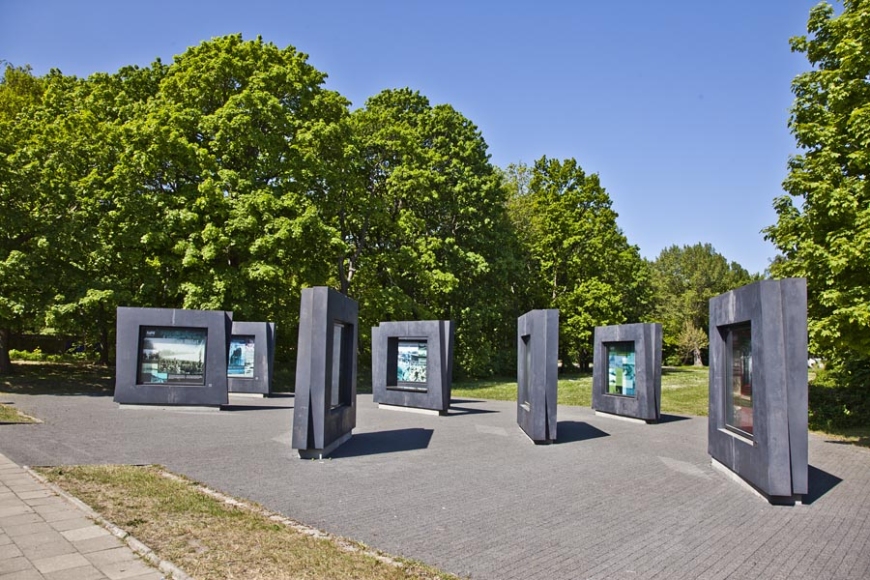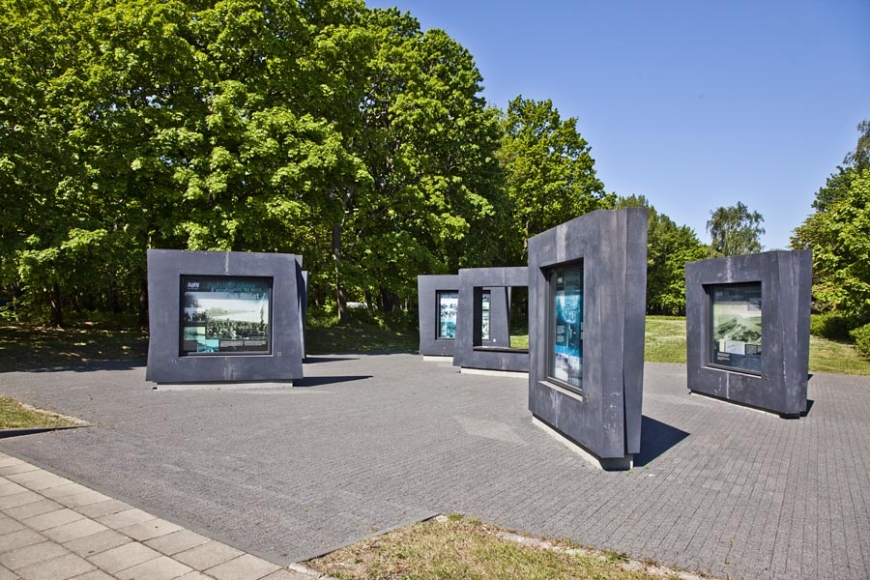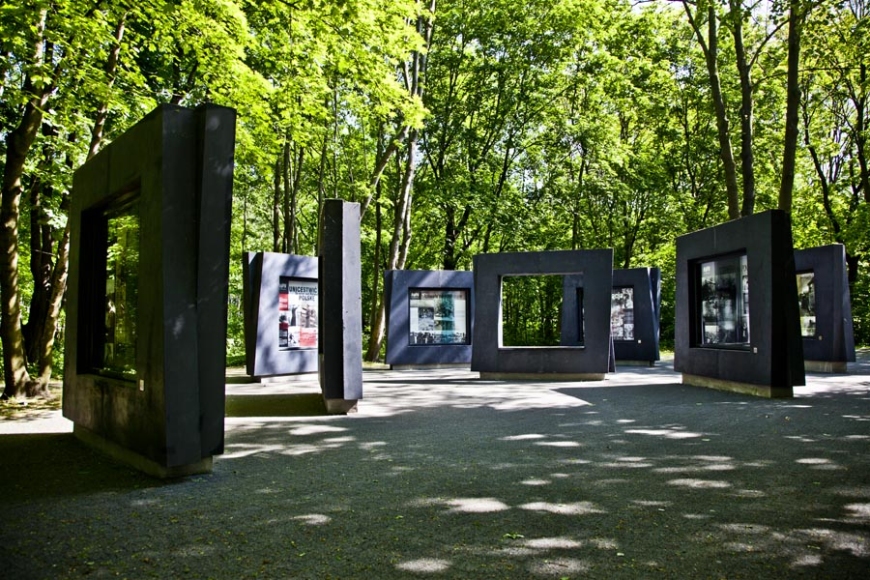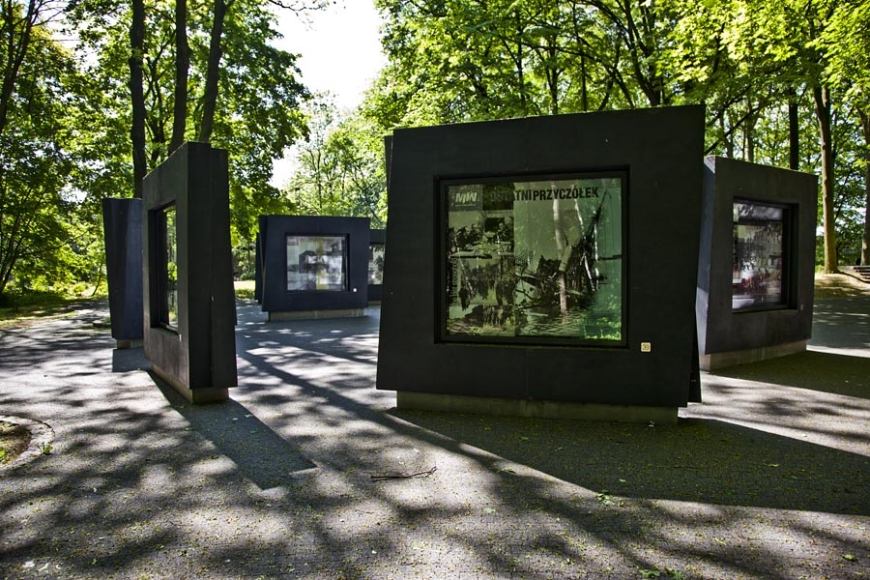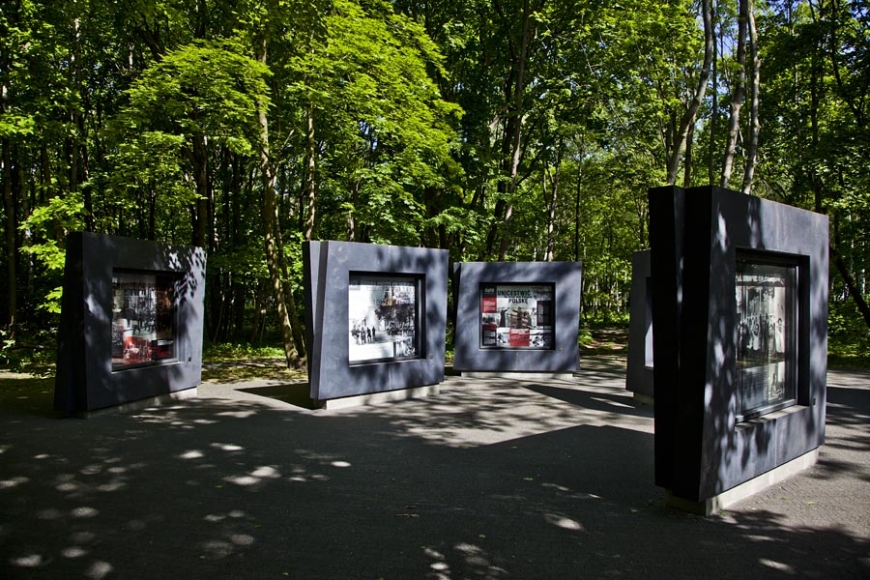Exhibition on westerplatte
The outdoor exhibition "Westerplatte: A spa – a bastion – a symbol", which had been curated by the Museum of the Second World War in Gdańsk was opened on 1 September 2009.
The exhibition is devoted to the history of the place that is commonly associated with the beginning of the 20th century’s greatest catastrophe, the Second World War. A place that, like Thermopylae before it, became the symbol of a heroic struggle against an overwhelming adversary. Yet the story of Westerplatte, as told by our museum, is not limited to the defence of Poland’s Military Transit Depot in September 1939; rather, we travel back to the peninsula’s formation in the 17th century as a sandbar at the mouth of the Vistula and forward, all the way to the fall of Communism in Poland in 1989.
The exhibition is divided into four areas, which correspond to the chronological phases of its story. The first one presents the processes by which the peninsula was created, and then shows the growth and the golden age of the spa, which lasted until the end of the First World War. The second segment is about the Polish Military Transit Depot, which was located here in the interwar period. The third part focuses on its defence in September 1939. The fourth section recounts Westerplatte’s place in Polish collective memory and in the politics of the Communist governments of 1945-89.
Over 200 maps, etchings, photographs and documents found in nearly 30 institutions in Poland and abroad help to tell its story, as well as texts in Polish and English.
Educational path
The educational trail on Westerplatte complements the "Westerplatte: A spa – a bastion – a symbol" outdoor exhibition, focussing on the peninsula’s architecture and topography. Information boards along the path tell visitors about the peninsula’s appearance during the fighting of September 1939. They also serve as a guide to the buildings of the Military Transit Depot, which was situated here in 1926-39, which makes it possible to take an interesting tour alone. There are historical photographs, etchings and maps on the boards, as well as texts in Polish and English.
The history of Westerplatte
The Westerplatte spa
The first holiday homes began to sprout on Westerplatte already in the mid-19th century, and there was an inn where guests could eat and spend the night. Westerplatte was a calm locality for rest and bathing until the 1880s, when the numbers of buildings and guests grew gradually from year to year. It developed vigorously in the 1880s and 1890s, and its appearance and character changed significantly. The small local bathing spot was transformed into a resort and health spa with close to 140,000 visitors annually.
A Gdańsk-based sailing company, the Vistula-Gdańsk Steamship Navigation and Seaside Resort Joint-Stock Company (Weichsel-Danziger Dampfschifffahrt und See-Bad Actien Gesellschaft), gave the impulse to this transformation. It constructed the 120-m. long Emperor’s Pier (Kaisersteg) on Westerplatte, with a marina for excursion ships, bathrooms for ladies, gentlemen and families, a spa building with a restaurant, a beach hall, a hotel, curative baths, tennis courts and a bowling alley.
Rest and therapy
In the summer season, the beaches of Westerplatte filled with multilingual and colourful crowds of visitors who came, often with their entire families, from various corners of the German Reich and the Kingdom of Poland, as well as from Gdańsk. They bathed in separate bathing areas for gentlemen, ladies and families, and afterwards rested in beach baskets.
Westerplatte was quickly transformed into a spa whose charms could be enjoyed year-round. Visitors not only bathed in the sea but also took medicinal baths (including brine, mud, sulphur, sitz baths, swing baths and those with spruce needle extracts, carbonic acid or iron). These treatments were to help treat kidney disease, anaemia, paralysis, women’s problems and rheumatism. Apart from taking sea and medicinal baths, the spa guests could pass the time walking or riding wagonettes on the beautiful promenades and paths marked out in the thick forest, which covered the peninsula all the way to Wisłoujście. Strolling along, for example, Linden or Birch Avenue, they could admire the original architecture of the spa buildings and their beautiful fountain-decorated gardens, in which concerts were often held. Wandering further, they passed through thick alder and beech groves, reaching the beaches. There, the broad pier encouraged visitors to continue strolling until, at its tip, they were rewarded with fabulous views. Walks on the beach, all the way to the stone blocks of the breakwaters shielding the entrance to Gdańsk harbour, offered another fabulous experience.
The grim neighbours
Yet views which had nothing to do with rest and recreation interrupted the idyllic walks and the sea- and landscapes. The ammunition shelters and coastal artillery positions being constructed on Westerplatte virtually alongside the spa buildings were conspicuous. Walking in the direction of the harbour canal, visitors might even come upon the remains of entrenchments from the second half of the 18th century, which had been constructed on the orders of Frederick the Great and expanded in the Napoleonic era and in the mid-19th century.
The twilight of the spa
The first sign of the waning splendour of Westerplatte was the drop in the number of visitors during the First World War. The uncertain situation that arose around Gdańsk even after the fighting ended did not favour en masse trips to this Baltic seaside. The spa’s best years were gradually being left behind, and it gradually reverted to being a local bathing beach. In 1919 the Polish Bank of the Union of For-Profit Cooperatives from Poznań became the owner of some of its land. A League of Nations resolution in 1924, which assigned the peninsula to Poland to construct its Military Transit Depot on it, put an end to the spa.
A bastion
The Free City of Gdańsk
The Paris Peace Conference, which convened in January 1919, created the Free City of Gdańsk. The Treaty of Versailles, signed on 28 June 1919, formally regulated its operation. According to the terms of the treaty, the League of Nations would serve as its protector. Article 104 of the treaty announced that a convention would be signed to regulate in detail Poland’s rights in the Free City. This convention was signed by representatives of Poland and Gdańsk in Paris on 9 November 1920. It guaranteed Poland’s right to a duty-free zone in Gdańsk harbour, and the enclosing of the entire Free City within the Polish customs zone. It granted the Polish government the right to use waterways, the harbour, harbour installations, railway lines, the post office, telephones and telegraphs to allow for the proper servicing of Poland’s trade via Gdańsk harbour. The guarantees also included respect for the civil rights of the Polish minority. The Polish authorities would represent the interests of the Free City and its citizens in the international arena.
The Bolshevik threat
During the Polish-Bolshevik War, Poland received military supplies from France, Great Britain and the United States. Germany announced its neutrality, which meant that arms could not be transported to Poland across German territory. There remained the sea route via Gdańsk. Polish diplomatic endeavours led to the signing in April 1920 of a Poland-Gdańsk agreement, according to which “Gdańsk guarantees granting all assistance for the dispatch of all kinds of transports unloaded in its harbour and destined for Poland, including transports of war materiel. Concerning the latter, Polish guards may serve as convoys for such transports with the caveat that the administrative authorities of Gdańsk will issue prior permission.”
The Polish guard unit
In light of these events, Poland engaged in diplomacy and received permission from the League of Nations representative in Gdańsk, Reginald Tower, and the Commander of Allied troops, Richard Haking, to bring a Polish garrison to Gdańsk to guard the arms transports to Poland. The unit arrived in September 1920, and its 60 soldiers were lodged in the old barracks in the New Port. The Gdańsk government protested.
The military transports destined for Poland were being unloaded in the docks of Holm Island or in the Duty Free Wet Dock. On 22 June 1921 the League of Nations recognised Poland’s rights to have a special location in Gdańsk where its military supplies could be handled and to maintain a small guard unit to watch over it. But it did not specify where the trans-shipment area would be located.
Problems with locating the depot
The establishment of the Polish Military Transit Depot encountered numerous obstacles. The Harbour and Waterways Council proposed Holm Island, where the deliveries were being provisionally trans-shipped. Neither the Gdańsk nor the Polish authorities accepted this proposal. The city’s government wanted it to be located on the Vistula Cut to the open sea near Świbno, but the Poles rejected this idea. Because of their inability to agree, the League of Nations High Commissioner in Gdańsk, Richard Haking, decided to locate the Polish Military Transit Depot on Westerplatte Peninsula. To make the trans-shipment more efficient, he recommended constructing a wet dock. The Polish government and the Free City of Gdańsk were to fund it. Neither agreed to do this.
The selection of Westerplatte
The disagreement led the Council of the League of Nations to create a questionnaire committee with the mission of finding a place for the Military Transit Depot in Gdańsk. The committee began its work in early 1924. After analysing all likely locations, it decided that Westerplatte Peninsula would be the best one. On the basis of this finding, the Council of the League of Nations voted to give the Westerplatte Peninsula to Poland, setting aside areas for trans-shipping, storing and expediting military materiel. The Harbour and Waterways Council was to construct the trans-shipment wet dock and a railway line. Until these were built, Poland would continue using the trans-shipment facilities on Holm Island.
The spa disappears
Until this time, the population of Westerplatte had consisted of locals and Polish civil servants, who temporarily occupied buildings belonging to the Polish government. It also served as the city beach, and a handful of bed-and-breakfasts survived from the spa. The date of handing the peninsula over to Poland, which was set for March 1925, was unrealistic. Some residents of Gdańsk criticised the whole undertaking, as they opposed the elimination of the bathing resort and the construction of the depot, which to them represented a threat to the city.
Preparations for construction
Rear Admiral Jerzy Zwierkowski became the plenipotentiary for the construction of the depot. Building a new wet dock and warehouses for arms, ammunition and explosives was a priority. Some residential buildings were to be turned into barracks for the guard unit, and others were to be torn down. In August 1924 the Ministry of Military Affairs began to build the depot. The munitions basin was to be placed on the western side of the peninsula. Continental Bau A.G. of Gdańsk and Władysław Szawernowski’s Warsaw-based company were charged with its construction. Despite difficulties stemming from delays in deliveries of construction materials, the munitions basin was completed in November 1925. It was 10 m. deep, with a 300-m.-long south-western shore, a south-eastern one of about 150 m. and a north-eastern one of 500 m.
The transfer of Westerplatte to Poland
On 31 October 1925, the Harbour and Waterways Council drew the boundaries of the Polish depot on Westerplatte. They ran along the harbour canal (but did not touch its shore, which was placed under the jurisdiction of the Harbour and Waterways Council) to the base of the eastern pier at the entrance to Gdańsk harbour. From there it continued to the beach of the Bay of Gdańsk and cut across the base of the peninsula at Zakręt Pięciu Gwizdków (Five Whistles Corner). It covered 60 hectares and had a circumference of 3.5 km. On 31 October 1925 Poland obtained Westerplatte with a perpetual lease.
The Polish government was not permitted to erect fortifications of any type on the grounds of the depot. The military area of Westerplatte was to remain closed to the public, and only those carrying passes could enter its grounds. Some Free City authorities had access to the peninsula to conduct inspections.
The Council of the League of Nations set the maximum size of the depot garrison at 88, to include two officers, 20 non-commissioned officers and 66 privates. The first guard crew arrived in January 1926.
The growing importance of the National Socialists in Gdańsk from 1930
In the first years of its activity in the Free City, the National Socialist German Workers’ Party (NSDAP) served solely as a political backdrop and did not enjoy much popularity among the residents of Gdańsk. This changed after the Volkstag elections of October 1930, in which it won 12 seats, becoming the second-largest political force in the city. At around that time, Albert Forster, Hitler’s appointee as the NSDAP Gauleiter, arrived in Gdańsk. His mission was to strengthen his party’s position.
The German Navy’s courtesy visits to Gdańsk
The Hessen arrived in Gdańsk in July 1927. It was the first German Navy vessel to visit Gdańsk harbour since the creation of the Free City. Her visit was official, and the city government and its German population received her enthusiastically.
In the following years, other German war ships sailed into Gdańsk harbour, demonstrating Germany’s stance on the question of Gdańsk. In 1934-1937 they included the training sailing ship Deutschland the heavy cruiser Admiral Scheer, the cruiser Leipzig and a squadron of six minesweepers of the Kriegsmarine. The last arrival, which would have tragic consequences for the Military Transit Depot – and for Poland – was that of the battleship Schleswig-Holstein. Each visit met with an enthusiastic reception of the Gdańsk authorities and a passionate reaction from the city’s German population.
Expanding the defensive installations
The Polish military authorities decided in the summer of 1933 to build guardhouses and barracks on Westerplatte. They were to form a defensive ring to protect the garrison from an attack. Their construction began in 1933 and was completed in 1936. The undertaking was clandestine.
Westerplatte goes on alert
In the spring of 1939, faced with an approaching confrontation, the authorities put the Military Transit Depot on alert and began preparations for its defence. An alarm system was installed for the eventuality of an attack, the grounds were totally blacked out at night, trains entering the depot were thoroughly searched, the defences were armed more heavily, telephone lines were inspected, entanglements and trip wires were laid down and the forest was thinned out in the range of machine-gun fire.
The Schleswig-Holstein in Gdańsk
The German training battleship Schleswig-Holstein arrived in Gdańsk harbour on 25 August 1939 on the pretext of a courtesy visit. The people of the city greeted her with great euphoria. She moored near the Salt Granaries, directly across from Westerplatte. Her officers took part in a ceremony to commemorate the fallen sailors of the cruiser Magdeburg in 1914. There were official meetings with representatives of Gdańsk and of Poland. Nothing revealed the true purpose of the German vessel’s visit.
The Schleswig-Holstein was a training battleship with basic equipment of four 280-mm. cannon, ten medium-sized 150-mm. cannon and four anti-aircraft guns. There were 596 men on board, as well as 175 cadets and 60 gunners servicing the anti-aircraft guns. Under her deck was a company of 225 storm troopers, who had participated in the taking of Klaipeda and who had boarded her on the way to Gdańsk.
The Polish government became concerned about the Schleswig-Holstein’s prolonged visit, which was being justified by the need to replenish her petrol supply. The tense mood also affected the crew. The actions of the Gdańsk NSDAP activists and the battleship’s crew left no room for illusions: the men of the Military Transit Depot were facing an impending attack.
The defence of Westerplatte
War
On Friday, 1 September 1939, at 4.47, before sunrise, Commodore Gustav Kleikamp, the commander of the Kriegsmarine training battleship Schleswig-Holstein moored in the harbour canal across from the Wisłoujście fortress, gave the order to open fire at Westerplatte from the ship’s heavy, medium and light artillery. A moment later, the first shots rang out, and soon her 20-mm. anti-artillery guns joined in. The shells fell on the south-eastern side of the peninsula. The goal of the cannonade, which lasted about seven minutes, was to destroy a stretch of the wall of the depot, which on this side stood in the way of the attacking Kriegsmarine assault company commanded by Lieutenant Wilhelm Henningsen. Machine guns placed earlier on the other side of the harbour canal, across from Westerplatte, also opened fire on the depot.
The assault repelled
The garrison of Westerplatte, despite its preparedness, was rather surprised by the sudden and very fierce German attack. Major Henryk Sucharski ordered battle stations. The soldiers hurriedly manned their defence positions. When the German infantry struck, an instant after fire from the battleship had stopped, the Polish defenders were at their action stations. The Fort, Prom and Wał outposts and Guardhouse no. 2 bore the brunt of the assault coming from the base of the peninsula. The other Polish positions did not lie in the main line of the German attack, but were targeted by the enemy’s heavy machine guns, which had been positioned in the buildings on the other side of the harbour canal in the New Port.
The effective flanking fire from the Polish heavy and light machine guns, later supported by mortars, inflicted severe losses on the attacking German platoons. The secretly prepared and camouflaged trip wires, barbed wire entanglements and natural obstacles made it difficult for the attackers to move in the dense forest. The Germans were left with many dead and wounded and, despite the repeated strong support from the Schleswig-Holstein’s artillery, they did not succeed at breaking the Polish line of defence and were forced to retreat to their starting positions. The next German attack at 8.55 was more cautious, the troops moved more slowly and took better advantage of the natural cover. This still did not prevent losses, as the attack was stopped by machine gun fire from Guardhouses nos. 1, 2 and 5 as well as the Wał, Fort and Sgt Deik’s outposts. The German units retreated again and dug in at Mewi Szaniec.
The outcome of the first day
As the first day of defence neared its end, the Polish soldiers did not yield to the enemy, who was overwhelming in every way. Despite losing four dead and four wounded, having to abandon the Wał and Prom outposts and seeing their only 75-mm gun (which had accurately hit the machine gun nests in the New Port) damaged by the Schleswig-Holstein’s fire, they had fulfilled their most important duty: they held on for 12 hours. They were tired but able to continue fighting until – they thought – the imminent arrival of reinforcements.
The air raid
The second day of defence began very quietly. No one knew that it would bring the hardest test for the depot’s garrison. The battleship Schleswig-Holstein’s artillery joined in the action at about midday. It aimed not at Westerplatte but at Polish positions around Gdynia. The Polish soldiers, taking advantage of the longer period of calm, were cleaning and repairing their weapons. Some of them were able to eat a hot meal prepared in the barracks, and those who were not on duty in the action stations could get some sleep. The guardhouse and the outpost crews were on watch all day, but failed to notice that some of the civilian population was being evacuated from the New Port. Such was the calm before the storm, as the Germans were preparing an air raid against the Polish defence positions. At 17.30, some 60 Junkers Ju-87B dive-bombers took off from an airfield near Słupsk. They carried 500-, 250- and 50-kg. bombs, as well as machine guns. The depot’s defenders detected the bombers at about 18.00. Soon, the aircraft took turns diving from about 4,000 m. The air filled with the terrifying roar of motors and sirens. The Polish soldiers took refuge in the shelters near their action stations.
The bombing of the barracks and Guardhouse no. 5
The barracks were attacked by the first bombers, initially without success; subsequent bombs hit their target. The building was struck twice, but its special construction passed the test. The bombs first went through the building’s top two concrete floors, whose construction reduced the impact of the strike and dispersed the shock wave from the explosion. This allowed the third and last ceiling of the cellar, which served as a shelter for the whole barracks crew, to withstand the hit, and no one was even wounded.
A direct hit by a 500-kg. bomb did, however, wipe out Guardhouse no. 5. Only two soldiers from its crew survived, with serious injuries. Bombs dropped near Guardhouse no. 2 damaged it and destroyed ammunition warehouses nos. 2, 4, 5 and 7; the non-commissioned officers’ casino was also damaged. All four mortars, which had been left at their positions outside the barracks, were also wrecked by bomb explosions, as were the water supply system and the kitchen. From then on, the soldiers were afflicted by a shortage of water and they were left with only dry provisions, unable to cook.
The 30-minute air raid killed ten defenders of the depot and wounded six. The raid also had a serious psychological impact: for the majority of the Polish soldiers, it was a very powerful and paralysing experience, and some of them were unable to fight immediately afterwards. The system of defence had been weakened and disorganised. Had the Germans stormed then, the Westerplatte crew would have found itself in a very difficult situation. But no more attacks came that day.
Anticipating a German attack, Major Sucharski ordered the codes and the most important documents burnt, and then decided to surrender the depot. His decision met with resolute opposition from Capt. Franciszek Dąbrowski during a quasi-war council. In the end, the officers decided to continue to resist. The night of 2-3 September was calm, the crew covered their positions and the shock of the air raid gradually receded.
The war of nerves, 3-6 September
In the next days, the crew spent most of their time defending their positions from the enemy’s sporadic, but intensive, fire. The Germans were building up their forces. As early as 2 September, a pioneer company from Rosslau-Dessau had arrived in Gdańsk, and on the following day a battery of howitzers occupied positions around Wisłoujście. German light ships, the torpedo boat T-196 and later the torpedo boat Von der Groeben, appeared in the Bay of Gdańsk. On 3 September at night only a brief exchange of machine-gun fire took place. On the morning of 4 September, the T-196 began to shell Westerplatte from the Bay of Gdańsk, and the Von der Groeben joined in later. The shelling caused no human losses, but was stressful for the defenders. Also on the 4th, German heavy mortars took up positions near the Wisłoujście fortress. The 5th began calmly, but at 9.00 the battery of 105-mm. howitzers opened fire on Westerplatte from the area around Wisłoujście. It caused no major damages or human losses, but exhausted the already fatigued defenders. The condition of the wounded continued to deteriorate, since the depot’s surgeon, Captain Mieczysław Słaby, was unable to treat them. Shortages of water, surgical equipment and medicines meant that he could not operate and feared that the wounded men would develop gangrene.
On the night of 5-6 September the Germans made an attempt to set fire to the Westerplatte forest, which successfully camouflaged the Polish positions and made it difficult for the attackers to observe and take aim. They rolled a cistern containing a flammable substance onto the peninsula and planned to explode it near the Polish line of defence. But the cistern blew up prematurely near the German trenches, and the fire it caused went out quickly. 6 September began with regular heavy-mortar shelling from the direction of Wisłoujście. It was not very successful, although one of the shells blew up near Guardhouse no. 2 and damaged it, but caused no human losses. One person was wounded in the barracks. After 15.00, the Germans again attempted to burn the forest, this time bringing in two cisterns. The defenders were not surprised and opened fire from their heavy machine guns and a small anti-tank cannon. The cisterns exploded into a violent fire, which went out quickly and failed to bring the expected results. Calm returned to Westerplatte in the evening and at night.
The final battles
On 7 September at 4.30, the Schleswig-Holstein again began to shell Westerplatte. A moment later, fire was also heard from the heavy machine guns located on the upper floors of the buildings in the New Port. At 5.00 the German infantry, advancing cautiously, began to reconnoitre the Polish positions. They were stopped by fire from Guardhouses nos. 1 and 2 and from the Fort, Bieniasza and Sgt. Deik’s outposts. The Schleswig-Holstein directed her fire at Guardhouse no. 2, seriously damaging it and removing it from further fighting. At about 7, the Germans began to retreat, under cover of the battleship Schleswig-Holstein’s anti-aircraft gun fire. After their infantry departed, they once again tried, again without success, to burn the forest with a petrol-filled cistern.
Surrender
The defenders of Westerplatte found themselves in a very difficult situation. Guardhouses no. 2 and 5 were out of the fight, Guardhouses nos. 1 and 4 were damaged, the number of wounded was growing and the condition of those who had been wounded early was desperate. There were shortages of water, medicine and bandages, and food supplies were disappearing. Major Sucharski decided to capitulate, and a white flag was hung in a barracks window. Some of the Westerplatte garrison gathered in front of the barracks for a last assembly, and then marched into captivity. The Germans escorted all the Polish soldiers who were able to walk to the environs of the Mewi Szaniec, where they were searched and their information was recorded. The wounded were sent to various hospitals in Gdańsk. The German leadership was afraid that individual buildings and the entire grounds of the depot may have been mined by the defenders, and it demanded that the Poles surrender them in person. The Polish officers were then moved to the Centralny Hotel and the non-commissioned officers and privates to a provisional prison in the Biskupia Górka fortress. The officers were transported to Oflags on 10 September and the rest of the men to Stalags on 12 September.
The losses
Fifteen Polish soldiers were killed and 26 wounded in the heroic defence of the Military Transit Depot on Westerplatte, but the casualties may have been higher. The number of dead on the German side is estimated at 50 and of wounded at 121. But these figures have also never been confirmed.
Hitler in Gdańsk and on Westerplatte
Adolf Hitler arrived in Gdańsk on 19 September 1939. Its people welcomed him as he triumphantly rode through the city. On 21 September he inspected Westerplatte, wanting to take a first-hand look at the “fortress” that had defended itself for seven days against the German battleship and infantry units and survived a dive-bomber raid and shelling by heavy howitzers and mortars. After examining the fortifications and grounds of the Military Transit Depot, Hitler walked on the shore, where the Schleswig-Holstein was moored, and from afar greeted the sailors assembled on her deck. In the following days, he visited Sopot and Gdynia.
The Germans defend Westerplatte
On 28 March 1945, German troops of the 73rd Infantry Division, pursued by Soviet armoured units, were forced to retreat from the New Port to Westerplatte. In the next three days, the Germans fought fiercely for Westerplatte, repelling several attacks by the Soviet 76th Guards Division. Finally, on 1 April 1945, the remaining German armies left Westerplatte and were evacuated east by sea.
A symbol
Westerplatte after the War
In July 1946, a small symbolic cemetery, with a cross and a list of the names of the Polish soldiers who had died defending Westerplatte, was established on the site of Guardhouse no. 5, which had been destroyed in September 1939. Westerplatte was then forgotten for a decade, since it had become an inconvenient symbol for the government of the Stalinist period. The image of heroic Westerplatte did not match the reality in which soldiers who had served in the pre-war armed forces were being persecuted. The arrest on fabricated charges of Major Mieczysław Słaby (who in September 1939 had served as the doctor on Westerplatte), his torture by the Secret Police and his death in March 1948 from wounds inflicted by his interrogators became a symbol. After the political changes of October 1956, former fighters returned to Westerplatte, but in 1962 the Communist government removed the concrete cross from the cemetery and replaced it with at T-34 tank.
Westerplatte as a propaganda visiting card for the government
In the early 1960s, Westerplatte began to play the role of a visiting card for the Communist government’s propaganda. It invited official state delegations from the whole world here and organised military ceremonies and official rallies. In 1966, a 25-m. monument to “The Defenders of the Coast” was erected on the peninsula. A few months later, a technically complex operation moved Guardhouse no. 1 a few dozen metres deeper into the peninsula. It saved the building from destruction, since its original location was to be used to widen the harbour canal. On 1 September 1971, Major Henryk Sucharski’s ashes were brought to the Westerplatte cemetery from Italy, where he had died.
Westerplatte during the collapse of the Communist system
Thanks to the “Solidarity” Trade Union in Gdańsk, in August 1981 a cross returned to the Westerplatte cemetery. Pope John Paul II’s June 1987 youth rally on Westerplatte became a symbol. It had deep moral meaning. Nineteen-eighty-nine brought more changes in the appearance of the symbolic place that is Westerplatte Peninsula, including the removal of the T-34 tank from the cemetery.
© The Museum of the Second World War in Gdańsk/Poland. Authors: Bartłomiej Garba and Marcin Westphal
Getting there
By a Gdańsk city bus:
Bus no. 106
This line operates daily year-round and also uses low-entry buses. It begins and ends just outside central Gdańsk. Its first stop is the Akademia Muzyczna bus terminus, which you can reach by bus or tram from the main train station. You should buy a one-hour or a 24-hour ticket, which will allow you to transfer between buses and trams. Its schedule can be found on the Gdańsk transport website at Zarząd Transportu Miejskiego w Gdańsku.
By a Żegluga Gdańska boat from the stop on the Długie Pobrzeże embankment.
Its schedule is available on the Żegluga Gdańska website.













